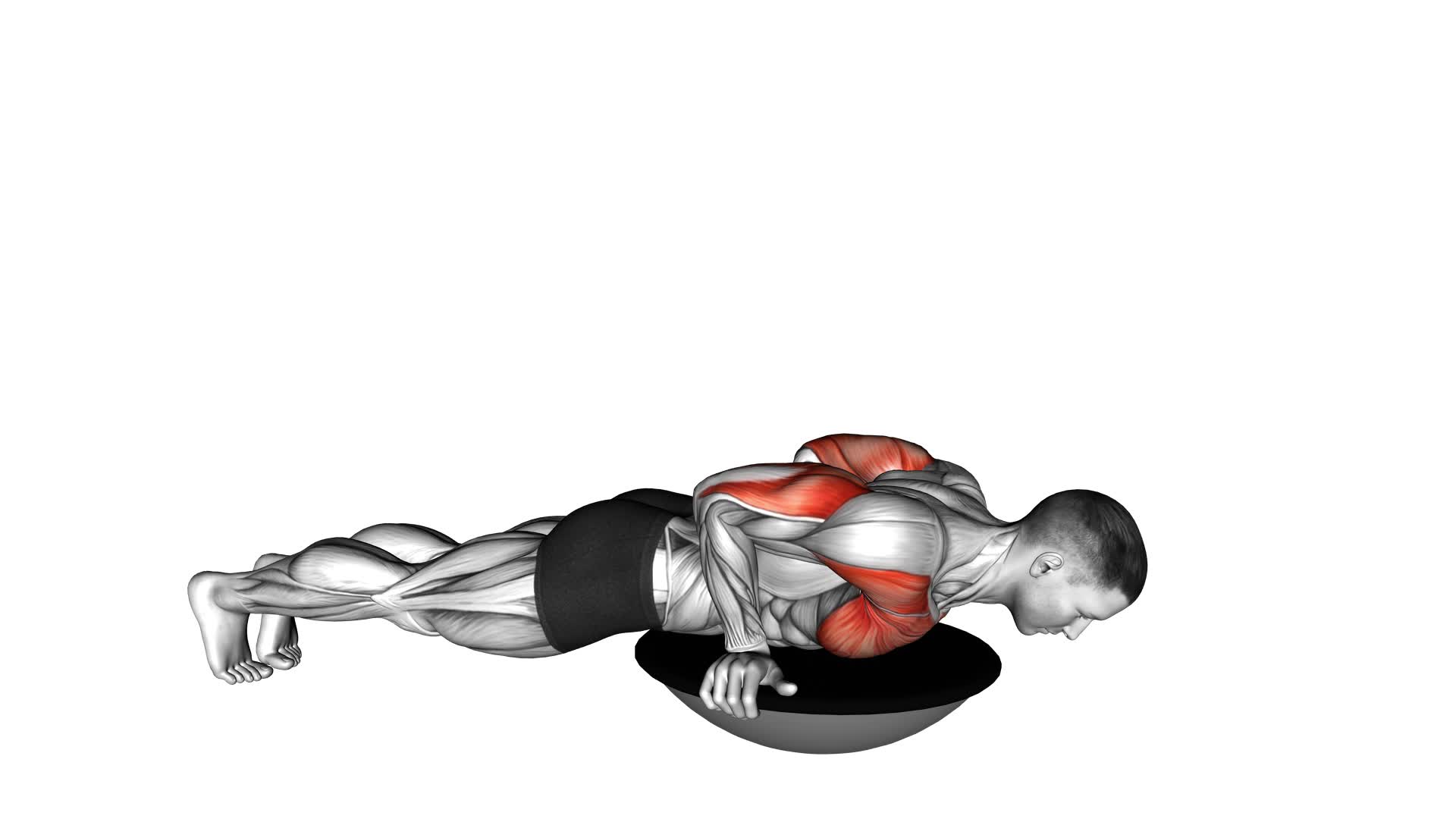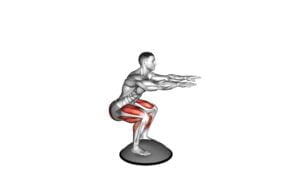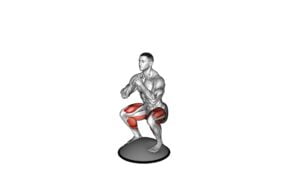Push-Up (Bosu Ball) – Video Exercise Guide & Tips

In this video exercise guide, you'll learn all about the Push-Up (Bosu Ball) and how it can benefit your workout routine.
Watch This Exercise Video
Get ready to amp up your core and upper body strength while improving your balance and coordination.
We'll show you the proper form and technique, as well as some variations and progressions to challenge yourself even more.
Avoid common mistakes and maximize your results with our expert tips.
Let's get started!
Key Takeaways
- Increased activation and engagement of core muscles
- Improved stability and balance
- Enhanced proprioception and coordination
- Strengthening of core muscles
Benefits of the Push-Up (Bosu Ball)
One of the key benefits of performing push-ups on a Bosu Ball is the increased activation and engagement of your core muscles. When you perform push-ups on a stable surface, such as the floor, your core muscles are still engaged to some extent. However, when you introduce an unstable surface like a Bosu Ball, your core muscles have to work even harder to maintain stability and balance. This increased activation of your core muscles not only strengthens them but also improves your overall stability and balance.
In addition to the benefits to your core muscles, push-ups on a Bosu Ball also provide advantages of unstable surface training. By performing exercises on an unstable surface, you challenge your body to constantly make tiny adjustments in order to maintain balance. This helps improve your proprioception, which is your body's ability to sense its position and movement in space. By enhancing your proprioception, you can improve your overall coordination and body awareness.
To perform push-ups on a Bosu Ball, you'll need a Bosu Ball and a flat, stable surface. Place the Bosu Ball on the ground with the dome side facing up. Position your hands on the outer edges of the Bosu Ball, slightly wider than shoulder-width apart.
Transitioning into the subsequent section about equipment and set-up for the exercise, let's now discuss the proper form and technique for performing push-ups on a Bosu Ball.
Equipment and Set-Up for the Exercise
To set up for the exercise, grab a Bosu Ball and place it on a flat, stable surface with the dome side facing up. The Bosu Ball is a versatile piece of equipment that can help you enhance your push-up workout. Its unique design adds an element of instability, engaging your core muscles and challenging your balance.
Before starting the exercise, make sure the Bosu Ball is in good condition and securely positioned to prevent any accidents. If you're a beginner or have limited upper body strength, you can modify the exercise by performing push-ups on your knees instead of your toes. This reduces the amount of body weight you need to lift, making the exercise more manageable.
Additionally, you can also place your hands on the outer rim of the Bosu Ball instead of the center to provide more stability. Remember to maintain proper form throughout the exercise, keeping your body in a straight line from head to toe.
Proper Form and Technique
To perform the push-up exercise on a Bosu Ball with proper form and technique, there are a few key points to keep in mind.
First, avoid arching your back by engaging your core muscles throughout the movement.
Second, make sure to keep your elbows close to your body as you lower yourself down and push back up.
Avoid Arching Back
Are you unsure how to maintain proper form and technique to avoid arching your back during the Bosu Ball push-up exercise? It's crucial to improve your push-up form and prevent lower back strain.
Arching your back during the exercise can put unnecessary stress on your spine and increase the risk of injury. To avoid arching your back, start by positioning your hands slightly wider than shoulder-width apart on the Bosu Ball.
Engage your core muscles by tightening your abs and glutes, keeping your body in a straight line from head to toe. This will help stabilize your spine and prevent excessive arching.
Engage Core Muscles
Engage your core muscles by tightening your abs and glutes to maintain proper form and technique during the Bosu Ball push-up exercise.
Core stability is essential for balance training, and it plays a crucial role in this exercise. By activating your core, you create a solid foundation that allows you to perform the push-up with control and stability.
Start by drawing your belly button towards your spine to engage your abdominal muscles. Then, squeeze your glutes to activate your hip muscles. This will help keep your body in alignment, preventing your back from sagging or arching.
Remember to maintain this engagement throughout the entire exercise to maximize the benefits of the Bosu Ball push-up and protect your spine.
Elbows Close to Body
Keep your elbows close to your body to maintain proper form and technique during the Bosu Ball push-up exercise. This is crucial because it helps you to reap the benefits of proper form and maintain stability throughout the movement.
When your elbows are close to your body, you engage your triceps, chest, and shoulder muscles more effectively, leading to greater strength and muscle development. Additionally, keeping your elbows in line with your body helps to prevent strain on your shoulders and reduces the risk of injury.
By maintaining this proper form, you ensure that the focus remains on the targeted muscles and that you're maximizing the effectiveness of the exercise.
Now, let's move on to the next section to explore some variations and progressions of the Bosu Ball push-up.
Variations and Progressions
Now let's explore some variations and progressions you can incorporate into your push-up routine.
If you're just starting out or have limited upper body strength, modified push-up options like knee push-ups or incline push-ups can help you build strength and improve your form.
As you become more advanced, increasing the difficulty level by trying one-arm push-ups or plyometric push-ups can challenge your muscles in new ways.
Modified Push-Up Options
Try incorporating different variations and progressions into your push-up routine to challenge your muscles and enhance your strength training.
Modified push-up options can help you gradually build up your strength and improve your push-up form. One modification you can try is the knee push-up. Instead of being on your toes, you can drop to your knees while keeping your body aligned and lowering your chest towards the ground. This modification reduces the amount of weight you have to lift and can be helpful for beginners or those with weaker upper body strength.
Another modification is the inclined push-up, where you place your hands on an elevated surface such as a bench or step. This reduces the intensity and allows you to focus on proper push-up form.
Experiment with different modifications to find what works best for you and gradually progress to more challenging variations.
Increasing Difficulty Levels
To further challenge your muscles and continue improving your push-up form, explore various variations and progressions that increase the difficulty level of the exercise.
Increasing intensity and incorporating advanced modifications into your push-up routine can help you build strength and endurance more effectively.
One way to increase the difficulty is by performing push-ups on an unstable surface, such as a Bosu ball. This requires greater core stability and engages more muscles.
Another option is to elevate your feet on a bench or step, which increases the load on your upper body.
You can also try incorporating explosive movements, such as clap push-ups or plyometric push-ups, to further challenge your muscles.
Remember to always maintain proper form and listen to your body to prevent injury.
Benefits of Progressions
To enhance your push-up routine and achieve optimal results, it's important to understand the benefits of incorporating variations and progressions. By incorporating progression techniques into your push-up routine, you can continually challenge your muscles and prevent plateaus. These progression techniques involve increasing the difficulty of the exercise over time, either by adding weight, changing the angle, or using unstable surfaces like a Bosu ball.
The benefits of incorporating variations and progressions in your push-up routine include:
- Increased muscle activation: By adding variations and progressions to your push-ups, you engage different muscle groups and activate them to a greater extent.
- Improved strength and endurance: Progressions challenge your muscles to work harder, leading to increased strength and endurance over time.
- Enhanced overall fitness: Incorporating variations and progressions in your push-up routine helps to improve your overall fitness level, as it targets different muscle groups and promotes balance and stability.
Remember to always start with proper form and gradually progress to more challenging variations to avoid injury and maximize the benefits of your push-up routine.
Common Mistakes to Avoid
To avoid common mistakes while performing a push-up on the Bosu Ball, make sure that you maintain proper form and stability throughout the exercise. One common mistake is allowing your lower back to sag or your hips to drop. This not only puts strain on your lower back but also takes away from the effectiveness of the exercise.
To correct this, engage your core muscles and keep your body in a straight line from your head to your heels. Another mistake is positioning your hands too far forward, which can put excessive pressure on your shoulders and wrists. Instead, place your hands directly under your shoulders to ensure proper alignment and reduce the risk of injury.
Finally, avoid rushing through the exercise. Performing push-ups too quickly can compromise your form and limit the benefits. Take your time and focus on maintaining control and stability with each repetition.
Tips for Maximizing Your Results
To get the most out of your push-up on the Bosu Ball, focus on maintaining proper form and stability throughout the exercise. Here are some tips for maximizing your results and using effective techniques:
- Engage your core: Keep your abs and glutes tight throughout the entire movement. This will help stabilize your body and prevent any unnecessary strain on your lower back.
- Control your breathing: Inhale as you lower your body towards the Bosu Ball, and exhale as you push yourself back up. This will help you maintain control and stability during the exercise.
- Gradually increase difficulty: Start with the basic push-up on the Bosu Ball and gradually progress to more challenging variations, such as the single-leg push-up or the push-up with a knee tuck. This will keep your muscles engaged and ensure continued progress.
By following these tips, you can maximize your results and make your push-up on the Bosu Ball more effective.
Remember to listen to your body, take breaks when needed, and always prioritize proper form and technique. Keep pushing yourself and enjoy the benefits of this challenging exercise.
Frequently Asked Questions
Can the Push-Up (Bosu Ball) Exercise Help Improve Core Strength?
Yes, the push-up (bosu ball) exercise can definitely help improve your core strength. By incorporating the bosu ball into your push-up routine, you're adding an element of instability, which forces your core muscles to work harder to maintain balance.
This exercise also allows for variations of push-ups, such as wide grip or diamond push-ups, which further target and strengthen your core.
Are There Any Modifications or Adaptations for Individuals With Wrist Pain or Injuries?
If you're dealing with wrist pain or injuries, there are modifications you can make to the push-up (bosu ball) exercise.
By using push-up handles or parallettes, you can reduce the strain on your wrists.
Another option is to perform push-ups on your fists instead of your palms.
These modifications can help alleviate discomfort and allow you to still benefit from using a Bosu ball for push-ups, which can improve core strength and stability.
How Often Should I Incorporate the Push-Up (Bosu Ball) Exercise Into My Workout Routine?
To maximize your results and reap the benefits of incorporating Bosu ball exercises into your workout routine, it's important to find a balance.
Start by considering your fitness goals and current fitness level.
Gradually increase the frequency of the push-up (Bosu ball) exercise over time, aiming for at least 2-3 times per week.
Remember to listen to your body and give yourself enough time to recover between sessions.
Consistency is key for optimal progress.
Can the Push-Up (Bosu Ball) Exercise Be Beneficial for Individuals With Lower Back Pain?
The push-up (Bosu ball) exercise can be beneficial for individuals with lower back pain. By incorporating Bosu ball exercises for overall strength and stability, you can help alleviate pain and improve your back's condition.
The Bosu ball provides an unstable surface, engaging your core muscles and promoting better balance. This can aid in rehabilitation and injury prevention, as it strengthens the muscles surrounding your lower back.
Remember to consult with a professional before starting any new exercise routine.
Are There Any Specific Breathing Techniques That Should Be Used During the Push-Up (Bosu Ball) Exercise?
During the push-up (bosu ball) exercise, it's important to focus on your breathing techniques. Proper breathing can help you maintain stability and control throughout the movement.
Take a deep breath in as you lower your body towards the bosu ball, and exhale as you push back up. This can help engage your core muscles and enhance the benefits of the bosu ball by improving your overall stability and strength.
Conclusion
In conclusion, incorporating the push-up on a Bosu ball into your workout routine can provide numerous benefits, such as improved core stability and upper body strength.
Remember to set up the equipment properly and maintain proper form and technique during the exercise.
By avoiding common mistakes and gradually progressing through variations, you can maximize your results and achieve your fitness goals more effectively.
Keep these tips in mind to get the most out of your push-up (Bosu ball) workouts.

Author
Years ago, the spark of my life’s passion ignited in my mind the moment I stepped into the local gym for the first time. The inaugural bead of perspiration, the initial endeavor, the very first surge of endorphins, and a sense of pride that washed over me post-workout marked the beginning of my deep-seated interest in strength sports, fitness, and sports nutrition. This very curiosity blossomed rapidly into a profound fascination, propelling me to earn a Master’s degree in Physical Education from the Academy of Physical Education in Krakow, followed by a Sports Manager diploma from the Jagiellonian University. My journey of growth led me to gain more specialized qualifications, such as being a certified personal trainer with a focus on sports dietetics, a lifeguard, and an instructor for wellness and corrective gymnastics. Theoretical knowledge paired seamlessly with practical experience, reinforcing my belief that the transformation of individuals under my guidance was also a reflection of my personal growth. This belief holds true even today. Each day, I strive to push the boundaries and explore new realms. These realms gently elevate me to greater heights. The unique combination of passion for my field and the continuous quest for growth fuels my drive to break new ground.



